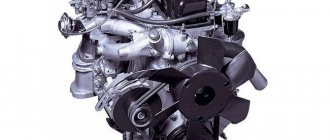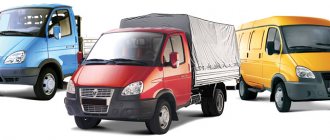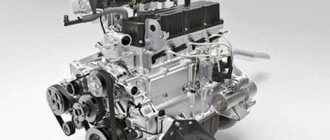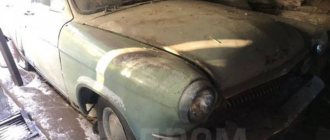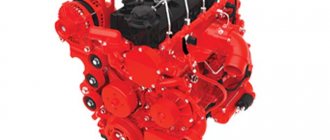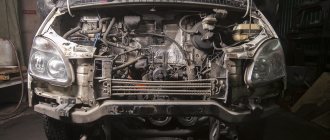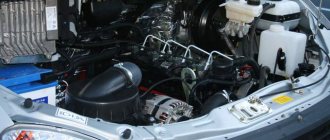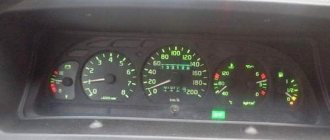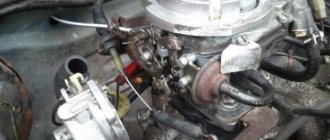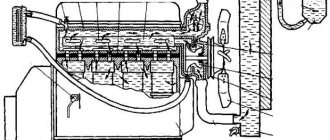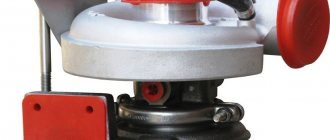When the lifespan of a Gazelle engine ends, many car owners think about which power unit is better to install instead of the outdated one. It will not be possible to swap an engine of any kind, because a certain engine modification is produced for each car model.
Let's look at the beginning of the main models of the Gazelle vehicle.
What brands of engines are suitable for GAZelle
When driving a vehicle with a gasoline engine, many motorists wonder whether it is possible to install a diesel engine on a GAZelle?
And really, with current gasoline prices you can’t travel much. The diesel engine in the GAZelle is popular among many motorists because it is economically beneficial. The GAZelle car line includes the following types of internal combustion engines: 402 engine, 405 and 406. In some cases, installing a new engine is much preferable and more profitable than repairing it. But of course, not every engine is suitable in terms of dimensions and parameters; you should consider which internal combustion engines are suitable for a car of the GAZelle family:
Installing a diesel engine gives the car a number of advantages, such as:
- Fuel quality. Modern diesel engines are not picky about fuel quality.
- Reliability. Such engines are highly reliable; if you change the oil on time, you can drive more than 500 thousand km without the need for repairs.
- Traction. Cars with such internal combustion engines have high traction at low speeds.
Now it’s worth considering each motor in more detail.
Applicability
As can be seen from the technical characteristics, the UAZ 100 carburetor engine has found wide application among a whole range of different automobile manufacturers. Thus, the Zavolzhsky Motor Plant produced a batch of Volga vehicles with a power unit produced by the Ulyanovsk concern. UMZ 421 was also installed on Gazelle.
Military equipment and combat vehicles did not go unnoticed, so the Ulyanovsk engine was installed on the UAZ 421 and UAZ 469, which were ordered by the Ministry of Defense for command personnel.
Cumminis
Cummins is an American-made engine that is assembled in China. Cars with such engines consume fuel economically, and they also have many positive qualities. Owners of cars with a Cummins diesel engine note the following advantages:
- there are no dips or vibration;
- quiet engine operation;
- stable and sustainable work.
Here is a small list of the main technical characteristics:
- 4 cylinders;
- engine volume 2.78 l;
- 120 hp ;
- turbocharging
According to the manufacturers, the mileage life of such a car before major repairs is 500 thousand km. In this case, fuel consumption varies from 8 to 11 liters, depending on driving speed.
But due to our low-quality fuel and many counterfeit spare parts, there are cases when it is necessary to repair the internal combustion engine earlier than the stated period; there have been cases when it had to be repaired already at 200 thousand kilometers. This engine has a design flaw; the oil sump is made of plastic, and it is quite easy to damage it on our roads.
Engine ZMZ-409
The ZMZ-409 Gazelle engine also deserves special attention. It should be noted that this internal combustion engine is designed for passenger cars and utility vehicles of the UAZ brand. However, it can be found on some Gazelles. Production began in 1996.
ZMZ-409 is a 4-cylinder engine with a volume of 2.693 liters and a power of 94.1 kW. Modern variations of internal combustion engines comply with Euro-4 requirements. Fuel consumption reaches 12 liters. At the same time, the ZMZ-409 has the same cylinder block as the ZMZ-405 model. Among the modifications it is necessary to highlight:
- ZMZ-409.10 - meets Euro-2 standards and has a power of 142.8 hp.
- ZMZ-4091 - produced in 2007, complies with Euro-3 and has a power of 125 hp.
- ZMZ-40904 - power is 142.8 hp, the head cover is made of plastic, the frame has dual-flow spray nozzles, and there is an absolute pressure sensor.
- ZMZ-40905 - similar to the previous one, but comply with Euro-4.
Nissan
Diesel engines from the Japanese manufacturer Nissan are also quite popular in the domestic market.
A car with such an engine can cover 600 thousand kilometers without major repairs. They are produced in several models: The advantages of these engines, which should be noted: high maintainability, reliable design, fuel consumption is 8-12 liters. The cast iron cylinder head housing (cylinder head) does not suffer from overheating. Also a distinctive feature is the quick access to operating temperature. Many motorists say about such engines: I install such an engine, and it works like a clock, quietly and stably.
Repair
Repair of the UMZ 100 carburetor engine is carried out by analogy with the ZMZ 402, since the power units are structurally very similar. Most car enthusiasts carry them out with their own hands, and then only the carburetor version. As for the injector, it is best to entrust the restoration of the power unit to professionals, since the presence of complex electronics does not always make it possible to repair the engine.
Repairing a UMZ 100 engine with a carburetor is quite simple. First, the power unit is disassembled and problems are diagnosed. After this, it is necessary to make all the necessary measurements, such as the crankshaft and cylinder block.
The next step is boring. The cylinders and piston group have the following repair dimensions: 100.5 mm, 101.0 mm, 101.5 mm. Subsequent boring does not make sense, and as practice shows, the block can be sleeved. That is, standard-sized sleeves are installed in it, which can be bored out during the next major overhaul.
As for the crankshaft, there is a standard repair dimension diagram. So, you can make a crankshaft groove in the following sizes: 0.05 mm, 0.25 mm, 0.5 mm, 1.0 mm, 1.25 mm, 1.5 mm. But no one dares to make the last two repair sizes, since the crankshaft becomes thin and under a large load for which the power unit is designed, it will break in half, which will cause even more damage to the engine.
The block head, as practice shows, is completely rebuilt. The exhaust valves burn out so much that they cannot even be restored using a sandblaster. The guide bushings have a large wear and either change them or carry out the sleeve using the K-line technology.
GAZ 560
You can also install a domestic engine from the GAZ 560 on the GAZelle. Based on the results of the tests, the following results were summed up:
- unpretentious to fuel;
- starts well at sub-zero temperatures;
- high efficiency;
- low fuel consumption.
For a GAZelle (since it is mainly a commercial vehicle that carries out transportation), the main thing is that the car operates stably and without interruptions. For example, such an engine installed on the GAZelle Next car has proven itself from the best side. During the operation of the vehicle, it coped with its tasks perfectly. Now it’s worth considering the installation process itself, which you can do yourself.
Main models of the family
Gazelle vehicles have been produced since 1994. They are produced by the Gorky Automobile Plant. These are light-duty trucks that are used in construction, transporting various goods, transporting food to stores, and fuel in private destinations.
Let's see what modifications were released and whether they are still being manufactured. We will also find out what engine models were installed on this or that truck.
Attention! The permitted weight for transporting goods on Gazelle vehicles is 3.4 tons. The car can be driven by a driver who has a category “B” license. However, to modify the Gazelle passenger minibus, category “D1” will be required.
Diesel engine installation process
The replacement process itself is not complicated and will not be difficult, but if the owner is not confident in his abilities and does not have the necessary tools, it is better to leave this matter to specialists and take the car to a service station. However, if the motorist nevertheless decides to replace it on his own, then the first thing he should do is study the design of the engine; diesel and gasoline engines differ from each other.
The first step is to remove the hood, then turn off the power from the battery, and remove all additional equipment. Then, using a special winch, you need to pull the engine out of the engine compartment.
Now the new motor must be installed in the engine compartment, with the gearbox housing going in first. All fasteners should be lubricated with engine oil, then gradually lowering the engine, they are inserted into the grooves and tightened thoroughly.
Now all the removed parts are installed on the car in the reverse order. Next, you should start the engine and check it for proper operation, check that all warning lights on the instrument panel are working. If the engine works perfectly, the job can be considered done.
From this it can be seen that the replacement process itself is quite simple, you just need to have time and an assistant. By the way, if you change the engine at a service station, it will be quite expensive.
Engine UMZ 100 carburetor: technical characteristics and repair
The UMZ 100 carburetor engine is a power unit produced by the Ulyanovsk Motor Plant.
In fact, the UAZ 100 and UMZ 421 motors are one and the same. It was called “Sotka” because its cylinder diameter is 100 mm. It replaced the outdated ZMZ 402, which at the time of development was installed on UAZ vehicles. The main purpose of the engines was installation on UAZ vehicles, which were quite popular for military purposes. But the motor has become quite widespread among models such as UAZ, Gazelle, and others.
Results
It's time to take stock.
By installing a diesel engine in your car, the owner will significantly reduce the cost of purchasing fuel. Of course, initially you will have to pay a tidy sum for the purchase of a new engine, but then this money will quickly be recouped. In addition, cars with such engines have proven themselves excellent during operation. Many motorists who converted their car from gasoline to diesel were satisfied. Installation of engines from foreign cars on Gazelle
A gazelle is a machine used to transport goods. The question of which engine is better for a Gazelle is raised quite often and many car owners are interested in which internal combustion engine is better. The heavier the contents, the more gasoline is consumed. Which engine is better for the Gazelle: comparison and photos. A lot of waste occurs if you transport cargo over long distances. In this regard, the gazelle is equipped with an engine from a foreign car. Before carrying out such a function, you need to thoroughly learn all the aspects and dimensions of your own car. After choosing a motor for a Gazelle, it is necessary to compare the functionality of the car and the technical data of the selected motor; the size of the unit and its dimensions play a big role.
Appearance of Gazelle-Next
GAZ 33023 Gazelle-Farmer (produced since 1995).
Engine ZMZ 405 2.5 l.
This motor was created based on the example of the 406, the ZMZ 405 was simply “edited”.
The length of the cylinder blocks remained the same, the inter-cylinder bridges became much thinner, and the piston diameter was increased by 3.5 mm. In general, nothing else has changed: the motor block remains the same, there are no other special additions. The only thing is that the horsepower has increased by 7. And that’s all, otherwise it’s the old 3M3 406.
- Chain hydraulic tensioners of the gas distribution mechanism. The timing belt jams, noise appears, and the chain itself is often damaged.
- Overheat. Temperature problems often occur. It is necessary to check the radiator and the presence of cooled liquid.
- Oil is leaking.
- Constant knocking. Again, hydraulic compensators, which are designed for 50,000 km. create a knock.
- The engine stalls. This problem usually occurs due to a problem with the wires.
All the shortcomings are the same as the 3M3 406, every single one, there are no changes on this side. But I can say that if you have a question about which engine is better for a gazelle (meaning 405 and 406), then of course it’s better to go with the 405.
Modified 405 engine parts include carburetor and engineering.
The disadvantages of the engine repeat the disadvantages of its predecessor, so we can say that the 405 is the second 406, just younger.
Engine UMZ 421 / 4213 / 4215 / 4216 / 4218 2.9 l.
This engine is already more serious than the previous ones, but, of course, it also has its drawbacks.
This engine is considered one of the best; it is a reconstruction of the GAZ-21 model. The fuel supply here is injection, which is very, very good. There is already a larger volume here, and there are also exhaust valves. UMP are not particularly different from ZMZ (well, the fact that the plants are different - Zavolzhsky and Ulyanovsk - is understandable), but still there is a difference.
UMZ-421 has a high block strength, because the cartridges are no longer made wet, as before, but dry. The cylinder diameter here is 100 mm (compared to the 92nd diameter of the ZMZ 406). The pistons are shifted in the UMP by 7 mm, and the packing, which always gets in the way of everyone, has been replaced with a rubber cuff. In principle, these are all innovations, and they are not particularly different from the 1956 engine. Except with a smart presentation.
There is one big drawback - the lack of hydraulic compensators, so every 10,000 kilometers you need to adjust the valve clearance. This UMZ-421 is similar to the 402.
Malfunctions and technical problems are completely identical to ZMZ-402. In principle, the motors are made virtually the same, so this is what happens. The only problem that was solved was the problem with the padding, which was replaced with rubber. But in general, all the trembling, vibration, knocking - all this remains. The lack of hydraulic compensators also means that every 10,000 km you will have to pause your trips.
But why be surprised - the motor is already 70 years old, so criticism here, in my opinion, is inappropriate.
Engine ZMZ 511 (produced since the 80s)
This engine is already quite advanced, and uses a highly turbulent combustion chamber and helical inlet ports. That is, the fuel burns very, very quickly, and it also burns completely. Engine performance has been improved, and gasoline consumption at low speeds has been reduced.
The best engine for a Gazelle
A profitable option is a diesel engine. The Chinese Cummins is a factory engine that fits in size and is simply installed under the hood, leaving space. Which engine is better for a gazelle? | autobrands.ru. Since it is diesel, its fuel is comparatively cheap. But, parts for such an engine are very expensive and rarely available for sale. To find and acquire one component, it takes a lot of time to search for it, as well as for your own health. So which engine is better?
This is what the Cummins engine looks like installed in Gazelle-Next
Japanese-made engines, such as Nissan, have a huge advantage:
- Features a reliable mechanism;
- It is relatively easy to carry out repair work;
- At low revs, the car has quite powerful acceleration and passes difficult sections of the road quite easily;
- With timely diagnostics and identification of small problems, the engine will last a long time until it needs to be repaired.
- Fuel consumption is at least 11 liters. (per 100 km) at permissible speed.
Watch the video: technical review of the Gazelle with the Nissan engine.
The main ones are Nissan QD32ETI and TD27TI engines. Systematization of Nissan engines:
Nissan QD32ETI 3.2 l. – diesel fuel. Has 4 cylinders; engine volume 3153 cm3.; motor power 150l/s.
Nissan TD27TI 2.7 l. – diesel. Engine volume – 2663 cm3; motor power 130 l/s.
There are also 3.2 liter Nissan QD32 power units. and Nissan TD27T 2.7 liter.
Motors of the Nissan QD32TI and TD27TI series are cast iron, they do not deform due to temperature changes. The engines are very reliable. They have no electronics or belts. Carburetor for Gazelle 402 engine: which one to choose? The gears drive the high-pressure and timing gear drive. If you put such an engine on a gazelle, then you can forget about a whole series of problems. You only need to change the oil and filters on time. Changing spare parts for the engine will not be difficult, since they are provided by the market in sufficient quantities. Nissan engines justify their quality and positive reviews by their functionality.
We advise you to take a look at how the Nissan TD27TI engine works.
GAZ 3302 Gazelle. Onboard (manufactured since 1994).
Engine ZMZ 402 2.45 l.
This is the most famous engine for a gazelle. But its modified “Brothers” are also suitable for the Volga.
The engine consists of an aluminum block, there are also wet liners made of cast iron. The movement of the valves is carried out using rods and rocker arms.
Now about the disadvantages:
- Rear crankshaft oil seal. This lubricated rope begins to break after 2500 rpm and the oil begins to leak. You can, of course, replace the oil seal, but it will last you until the next 2500 rpm. "Crazy" design. The design of the engine, like the carburetor too, is very “crooked”. The liquid mixture is supplied unevenly to the cylinders, so there is constant twitching and shaking.
- Knocks. Usually a knock is heard due to the valves, so it is advisable every 15,000 km. adjust the valve clearances so that there is no such knock. Some solve the problem using hydraulic compensators.
- Constant vibration in the engine. Most often, vibration is caused by an airbag (more precisely, several), but it may also be a problem with the carburetor or ignition system.
- Overheat. Because the temperature rises too high, the washers begin to be pressed in, and the nuts are held much weaker. To avoid this, you need to tighten the gaskets in a timely manner.
Naturally, the list of these shortcomings can be enumerated forever, but you need to understand: the engine is not new, and for its age it is quite good. Spare parts are available and cheap, so there are no problems with this.
Engine ZMZ 406 2.3 l.
This engine is the predecessor of the previous one. It is much newer and, of course, better quality.
The aluminum block has now been replaced by cast iron, the camshafts are located at the top, and there are now two of them. Engine with 16 cylinders. They also solved the biggest problem that the ZMZ 402 2.45 liter engine had - hydraulic compensators finally appeared. And now you don’t need to adjust the valves every time.
- Chain hydraulic tensioners of the gas distribution mechanism. The timing belt jams, there is no vibration, noise appears. Sometimes the chain itself can become damaged.
- Overheat. For some reason, this particular model constantly has problems with temperature. It is necessary to check the radiator and the presence of cooled liquid.
- Oil is leaking. These could be oil scraper rings and seals.
- Constant knocking. Typically, knocking is created by hydraulic compensators, which are designed for 50,000 km. But if it's not them, then there could be a lot of reasons - you might even have to go through the entire engine.
- The engine stalls. This problem usually occurs due to a problem with the wires.
This engine, in principle, is also relatively cheap to operate, and spare parts for it are very, very easy to find. Of course, in terms of quality it has made great strides forward in comparison with its “dad,” but there are still big disadvantages associated with electronics.
If we compare these competitors with each other, then the best engine for a gazelle will still be a new option. After all, this model has been modified and made better.
Distinctive advantages of the Japanese engine over the “native” one
Nissan. The installed engine will go through actual mileage and will not require repairs. Only oil and filter changes. Unlike a native or Chinese engine, which cause problems already at 50,000 mileage. From time to time, repairs are required earlier. posted to Engine: Good afternoon, tell me which carburetor is better to install on a 402-door gazelle, preferably an economical one? With a mileage of 150 thousand, the engine requires six months of repair.
Very good traction at low revs. The Japanese engine installed on the Gazelle behaves excellently in certain situations on the road. No need to increase gear. In winter, there is no slippage when the car is stuck in a snowdrift. In the first downshift, the 1st axle, the accelerator pedal is slightly depressed and the Gazelle leaves the difficult place without the help of others. Unlike the original engine of the car. In a difficult situation, the car is tearing itself apart with all its strength.
Installed Nissan td27t engine on Gazelle-Next
Nissan. Fuel consumption with the TD27T engine and the factory engine.
Standard Gazelle: 9 l. (per 100 km.) at permissible speed on the open road; 10 l. (per 100 km.) at the permitted speed in us. Fri “Native” Gazelle engine “eats” from 15 to 20 hp. (per 100 km) permissible average speed.
Gazelle extended: 10 (per 100 km) at permissible speed in a populated area; 11l. (per 100 km.) at the permitted speed on the highway. Sable: 9 l. (per 100 km.) at average speed.
Watch the video: how the Nissan qd32t engine works on the Gazelle.
- There are no cracks in metal Nissan engines.
- Due to the absence of a belt, there are no problems with stretching, loosening or breaking.
- In winter, the engine showed itself on the positive side - warming up the car and heating the cabin.
- Fuel injection pump ( high pressure fuel pump) – mechanical. The driver controls the amount of fuel injected. If the car stalls, you can start it with a “push”, from a hill.
- The injection pump is electric: the most powerful torque provides good traction with the lowest diesel fuel consumption.
Service
Servicing the “weaving” of the power unit on an UAZ is quite simple. So, for the first it was calculated that traction and throughput forces were required, but for the second - a transport load.
So, let’s describe how service maintenance is carried out for UAZ vehicles with a 100 engine:
Maintenance - 1: involves changing the oil and oil filter. Also, if maintenance is carried out by yourself, then adjustment of the valve mechanism is required. At car services, this procedure is not always carried out, but it is provided for in the technological maps. Maintenance is carried out after 2500 km, whether it is a new car or after a major overhaul.
TO-2: Carried out after 10-11 thousand km. Includes replacing the oil filter element, lubricant and fuel filter.
TO-3: carried out after 20,000 kilometers traveled. This maintenance includes the following operations: changing the oil and oil filter, adjusting the valves, changing the air and fuel filters, replacing the valve cover gasket and in-line repairs.
TO-4: 30,000 km. During this maintenance, the oil and filter are changed, the timing chain is checked and, if necessary, replaced, as well as the coolant is changed.
Subsequent engine maintenance is carried out according to the technological map: changing the oil and filter is mandatory, everything else is as necessary. It is worth understanding that the air filter is replaced every 20,000 km, and the gas distribution mechanism kit is replaced every 45-50 thousand km.
If we consider a UAZ with a Sotka engine, then the service map is slightly different.
Let's look at how the maintenance of power units installed on GAZ vehicles is carried out:
Maintenance - 1: involves changing the oil and oil filter. Maintenance is carried out up to 1500 km, whether it is a new car or after a major overhaul.
TO-2: Maintenance No. 2 is done every 10-12 thousand km. Includes replacing the oil filter element, lubricant and fuel filter.
TO-3: carried out after 20,000 kilometers traveled. So, what needs to be done during the work: changing the oil and oil filter, adjusting the valves, changing the air and fuel filters, replacing the valve cover gasket and in-line repairs.
TO-4: After 35,000 km. This maintenance includes changing the oil and filter, checking the timing chain and, if necessary, replacing it, as well as changing the coolant.
As with the UAZ, further engine maintenance is carried out according to the technological map: changing the oil and filter is mandatory, everything else is as necessary. It is worth understanding that the air filter is replaced every 20,000 km, and the gas distribution mechanism kit is replaced every 45-50 thousand km.
Ford motor
The second most famous is the Ford engine. When installing this motor, the car owner forgets about a number of problems associated with repair work. And also, if you install such an engine on a Gazelle, you can invest your finances once - buying a kit and the engine itself, as well as installation. After installation, large fuel costs are reduced. which carburetor is better for the gazelle 402 engine -. This is very beneficial when traveling long distances with a heavy load. Which is better to take a gazelle: a new one with a 402 engine or a used one with a 406.405 engine? And what is the best engine for “Gas equipment”? I settled on Avensis, Which engine to choose 1.8 or 2.0, Avensis 1.8 automatic transmission. Fuel consumption on the highway is 8-9 liters. per 100 km. revolutions up to 100 km/h. The engine has a belt, but the quality of the manufacturer remains at the top, so you don’t have to worry about breakdowns during the trip. The technical data of the engine allow the car to drive easily and without unnecessary stress. It will not be difficult for the car to drive onto a hill. The gazelle becomes easy to control on serpentines.
Ford engine installed in a gazelle
To overhaul the engine, the Gazelle must “run” about 500 thousand km. Before that you need to change the oil and filters. The only thing is that if you have an imported FORD engine, then instead of the usual antifreeze, you should fill in imported antifreeze. This will prolong the life of the motor and also improve its functionality in the cold season.
Engine Specifications:
- Type - 4 cylinders, valves located up:.
- The working girth of the cylinders is 2496 cm3.
- The piston stroke is 90.54 mm.
- Turbocharged engine -18.3:1;
- Engine without turbocharging - 19:1;
Manual Transmission:
- (G) - 4-stage - 1.98 l;
- (G with divider) - 4-stage - 2.5 l;
- (N) - 5-stage - 1.5 l;
- (MT75) - 5-speed - 1.25 l;
- 3-speed - 6.3 l. (oil radiator);
- 4-speed - 8.2 l.
We advise you to look at how the Ford transit engine works.
The most popular gasoline power plants
Since its entry into the market, Gazelle has had several modifications of power plants, the most popular of which are:
Power plant ZMZ 402
This Gazelle engine is the most massive and widespread of all installed ones. Its production began in 1980 and continued until 2006, more than twenty years.
Characteristics of the ZMZ 402 power plant
- Cylinder block, material - aluminum;
- Power - carburetor;
- Cylinder arrangement/quantity, pcs. — in a row/4;
- Valves, quantity, pcs. - 8;
- Piston, stroke, mm. - 92;
- Cylinder, diameter, mm. - 92;
- Compression - 8.2;
- Engine capacity, cm3 - 2445;
- Power, hp - 100;
- Torque, Nm - 182;
- Fuel - AI-92 gasoline
- Engine weight, kg. - 181;
- Fuel consumption, l/100 km (city) - 13.5;
- Engine oil, l - 6.
Main malfunctions of the ZMZ 402 power plant
The advantage of the motor is the ability to install it on a large number of GAZ brand products. Repairing the Gazelle engine did not bring much trouble, due to the simplicity of the design and the large number of spare parts. Malfunctions:
- The rear crankshaft oil seal, when the speed exceeded 2500, began to drive oil out. The oil seal packing needs to be replaced.
- The uneven supply of the working mixture to the engine caused strong vibrations and noise. Tuning the carburetor solved this problem, but for a short time.
- Poorly adjusted valves created knocking noise in the power plant. Adjustment must be carried out every 15,000 km.
- The motor mounts quickly failed and created severe vibration. Worn parts needed to be replaced.
- When the Gazelle internal combustion engine overheated, there were several possible reasons: thermostat, pump, air lock in the cooling system. Frequent overheating of the engine led to loosening of the cylinder head nuts, and subsequently to burnout of the gasket.
Power plant ZMZ 406
The motor was a follower of the ZMZ 402 model and replaced it. Compared to its predecessor, significant changes have been made, making the installation more modern.
Characteristics of the ZMZ 406 power plant
- Cylinder block, material: cast iron;
- Power supply - injector/carburetor;
- Cylinder arrangement/quantity, pcs. — in a row/4;
- Valves, quantity, pcs. - 16;
- Piston, stroke, mm. - 86;
- Cylinder, diameter, mm. - 92;
- Compression - 9.3;
- Engine volume, cm3 - 2286;
- Power, hp - 145;
- Torque, Nm - 201;
- Fuel - AI-92 gasoline
- Engine weight, kg. - 187;
- Fuel consumption, l/100 km (city) - 13.5;
- Engine oil, l - 6.
Main malfunctions of the ZMZ 406 power plant
The engine was completely new, compared to its successor, and featured a cast-iron block, overhead camshafts, 16 valves and hydraulic compensators. Characteristic disadvantages were:
- Timing chain noise. Reason: failure of the hydraulic tension mechanism. Sometimes the chain could get stuck.
- The engine consumes a lot of oil. Reason: wear of oil scraper rings and valve seals, gap between the valve cover and the labyrinth oil deflector plate.
- Engine malfunctions at idle, sudden drop in power. Reason: faulty ignition coil, the unit requires replacement.
- Noise when the engine is running, knocking. Reason: hydraulic valve compensators, piston pins, pistons, connecting rod bearings, etc.
Power plant UMZ 4216
The power plant has become widespread due to its reliability and good performance. The main distinguishing feature is an increase in engine volume, larger valves and the installation of an injector for gasoline supply.
Characteristics of the UMZ 4216 power plant
- Cylinder block, material - aluminum;
- Power supply - injector/carburetor;
- Cylinder arrangement/quantity, pcs. — in a row/4;
- Valves, quantity, pcs. - 8;
- Piston, stroke, mm. - 92;
- Cylinder, diameter, mm. - 100;
- Compression - 8.2;
- Engine volume, cm3 - 2890;
- Power, hp - 125;
- Torque, Nm - 220;
- Fuel - AI-92 gasoline
- Engine weight, kg. - 170;
- Fuel consumption, l/100 km (city) - 12.5;
- Engine oil, l - 5.8.
Main malfunctions of the UMZ 4216 power plant
The power plant is, in fact, an improved version, replicating the GAZ 21 engine, but assembled at the UMP plant. Unlike ZMZ-402, dry cylinder liners were installed on the engine, thereby increasing the strength of the cylinder block. A rubber cuff was installed, which avoided oil leakage, and some other minor improvements.
Otherwise, the engine was similar to the ZMZ-402 and had the same problems and malfunctions.
Engine Iveco F1A
This type of engine is installed on commercial vehicles weighing no more than 6 tons. The Italian Iveco engine has 4 cylinders. The design of the motor resembles a sandwich. Because of this, it has high dimensions and is quite heavy. Toyota Avensis engine life Which engine is better for Avensis. The advantage is extreme rigidity, which is very important. The engine contains the following systems:
- turbocharging with exhaust gas recirculation;
- air flow cooling;
- fuel supply;
- combined type lubrication system;
- liquid cooling system using forced circulation.
External view of the Iveco F1A engine
Due to all the installation systems, as well as the cast iron cylinder block, the Iveco engine is called a power unit. Installing such a unit on a Gazelle is not difficult.
The technical characteristics of the Iveco power unit gave positive feedback about the unit. Which timing belt is better to choose for the VAZ-2112 16. It has 4 cylinders (diameter 88), weight - 250 kg, piston stroke - 94mm.
Watch the video: Iveco F1A engine repair.
Advantages and disadvantages of the motor.
- the advantage is a large resource;
- low fuel consumption (speed 90 km/h - 9.5 liters per 100 km);
- repairs are quick and economical
The main disadvantage is the mass. Which generator and battery for Land Rover and Range are better? Jaguar engine. The engine is very heavy.
Engine ZMZ 402
The most common engine that GAZ engines could boast of was the ZMZ 402. It was produced from the beginning of 1980 until 2006.
Now you can find it exclusively in a maintained form. This GAZ engine is the most common, as it has been produced for more than 20 years, which makes it easy to find the necessary spare parts and carry out repairs.
In terms of technical characteristics, it is not particularly different from its predecessors:
- The engine cylinder is made of aluminum, the power supply system is carburetor.
- Maximum engine capacity – 2115 cm3.
- This engine has quite high fuel consumption - up to 14 liters per 100 km in the city.
- One of the main advantages of this engine is its versatility, thanks to which it can be used on almost all GAZ cars.
Breakdowns and repairs of the ZMZ 402 engine
Despite the high quality and mass production of the Gazelle ICE engine, breakdowns still occur. These include the following malfunctions:
- One of the most fragile parts in the ZMZ 402 engine is the crankshaft oil seal. It is made from ordinary rope, pre-impregnated in graphite lubricant. The strength limit of such a part is up to 2500 rpm. If you exceed this figure, the crankshaft oil seal will simply begin to leak oil out. In order to avoid such unpleasant situations with ZMZ 402, the stuffing box should be replaced with a better one made of durable material;
- Abnormal vibration, unnatural sounds, and jerking may occur when the engine is idling. Such signs of malfunction may appear due to wear of the carburetor, since its design is initially crooked and is not the best solution implemented in Gazelle engines. Due to this feature, fuel is supplied to the engine cylinders in uneven parts, which leads to the malfunction described above;
- The occurrence of unhealthy sounds in the engine during its operation. Basically, the owner of a car with a GAZ engine is faced with knocking in the engine, which indicates a faulty fuel supply through the valve. In order to avoid such troubles, valve clearances should be adjusted in a timely manner. Basically, this car needs engine maintenance after every 15,000 km. If the knocking does not occur due to a crooked valve, then you should turn your attention to the connecting rod bearings or the camshaft.
BMW motor
When the letters BMW are heard, an association immediately arises with words such as quality and dignity.
Which BMW engine can be installed on the Gazelle ? Those who like to experiment use different engines. But in order to make such an installation, it is necessary to make some transformations in the Gazelle itself. Because one motor is a little longer, you have to cut off the manifold, the other motor is taller, then you need to make an additional hole in the Gazelle itself. WHAT IS BETTER TO PUT A CARBURETOR ON A 402 ENGINE Which carburetor is better on a 402 engine? But what car enthusiasts who want to combine economy and quality will not agree to.
Installed engine from BMW in Gazelle
This engine is so easy to handle and operate that in case of minor breakdowns or replacement of spare parts, you do not need to go to specialists for service, but can do everything in your garage. Oil also does not need expensive and high-quality oil. Because when engines were produced, oil production was in the first stages of development.
Most often, owners install a BMW M50 on a Gazelle. At the same time, it takes a little work to get it there, because the motor is 43.5 cm long and when installed, it goes under the bar of the car. We have to do a little work. The BMW M50 has an intake camshaft, it increases engine thrust at low speeds without losing power at high speeds. Motor weight 136 kg. compared to Iveco (250 kg).
We recommend watching: repairing and starting a BMW engine on a Gazelle.
BMW engines are classified:
- M50 V 20 - piston stroke 66 mm, power 150 hp, 6 cylinders (steel, direct arrangement), cylinder diameter 80 mm;
- M50 B25 - piston stroke 75mm, power 192 l/s, cylinder diameter 84mm;
- M50 V20TU Vanos – piston stroke 66 mm, power 150 l/s, torque 190 Nm.
Return to contents
Engine ZMZ 406
This is the next stage in the development of engines for the Gazelle, which replaced the ZMZ 402.
Despite the slight differences in the numbers between them, this engine has undergone dramatic changes compared to its predecessor.
The main differences include the following changes:
- changing the location of camshafts;
- 16 valve engine;
- hydraulic compensators are installed, which avoids the constant need for their adjustment;
- a significantly improved timing drive, the service life of which is 100,000 km, but in most cases can withstand loads twice as large. The engine camshaft is driven by gears with helical teeth. At the same time, a steel gear is mounted on the crankshaft, and a textolite gear with a cast iron hub is mounted on the distribution shaft to ensure silent operation.
But despite the general improvement in design and the use of more reliable components, this GAZ engine also has a number of serious drawbacks, due to which it is necessary to monitor the hydraulic tensioners and the condition of the chains quite often.
At the same time, it is difficult to overestimate innovations in the production of GAZ engines, especially when comparing the ZAZ 406 with the classic ZAZ 402.
Modification ZMZ 406
There are only three modifications of the ZMZ 406 engine:
The GAZ car engine runs on 76 gasoline and is of the carburetor type. At the moment it is rare, as it was produced in smaller quantities than other modifications and is now obsolete;
One of the most common modifications of the ZAZ engine. This Gazelle engine is also used on the Volga. Has an injection type of operation;
One of the latest modifications of the above-mentioned engine, running on 92 gasoline. This GAZ engine operates on a carburetor circuit.
Breakdowns of ZMZ 406
This type of motor may have the following malfunctions:
- Despite the stronger material used for hydraulic tensioners - metal chains, they also have some disadvantages that the driver may not have encountered when using a rope transmission. The timing chains on the engine can become jammed over time. Such a malfunction leads to unhealthy noise, vibrations appear in the operation of the engine, leading to the destruction of the shoe or the chain jumping;
- overheating of the ZMZ 406 engine. One of the most common malfunctions that appears when the radiator is dirty or the thermostat is malfunctioning. It is worth replacing the coolant with a new one;
- Due to wear of the hydraulic compensator, knocking noise may occur in the engine. This type of malfunction is most often encountered by owners of the ZMZ 406 and the GAZ 3307 engine. This malfunction also appears when connecting rod bearings, pistons and piston pins break.
Specifications
The main disadvantage of a “long” engine is that when it gets very hot, the gas joint becomes leaky. Because of this, cracks form on the cylinder head. After 300-400 thousand km traveled. mileage there is excessive oil consumption. Exhaust valves burn out and sometimes cracks appear.
From everything written above we can conclude: Gazelle is a unique car. If you have the opportunity and great desire to install the “heart” of the Gazelle, which will not only be economical in fuel consumption, but also greatly increase its functionality. The gazelle becomes hardy, powerful, and easy to control. She is very obedient in winter, on serpentine roads. With a good engine, a Gazelle can transport cargo and you don’t have to worry about the car not going uphill. Go on long trips with confidence and not worry about breakdowns.
Recent Entries
BMW 530e Hybrid revised for 2022
The BMW 530e PHEV has been updated with a new battery, improved efficiency, lower emissions and increased electric power range. The hybrid BMW 530e was
Watch a plane crash land on a public road, caught on police dash cam
Starman Adventures Is a Big Hit Among Teslas - SpaceX Fans
New deal offers drivers a free car - life-saving brakes for drivers up to £1,600
Categories
Test Drive
Ferrari Portofino 2019 review
Ferrari Portofino. this is a super stallion that you will ride every day Maximums Spectacular gearbox with excellent shift mechanics
What engine
is it better on a Gazelle?
Gazelle cars
They have been produced by the Gorky Automobile Plant since 1994. GAZ began production of the second-generation Gazel Next LCV-class car in 2013. The main power unit on the car is a Cummins 4.8 turbodiesel, and so far car owners have no special complaints about this engine.
Conclusion
The UAZ 100 engine is one of the most reliable and modern power units produced by the Ulyanovsk Motor Plant. Thus, the power unit has become widespread, and is installed on cars from such manufacturers as UAZ, Gazelle, Volga, as well as on military equipment.
Maintenance and repair of this unit is quite simple and does not require special knowledge and effort. Thus, even an inexperienced car enthusiast can replace the oil, oil filter and air filter element. As for the timing kit, replacing it will require some design knowledge and skills.
Source
Power units installed on Gazelle
When it comes to purchasing a used car, a potential buyer is often faced with the problem of choosing which Gazelle engine to choose - over the entire period of serial production, GAZ equipped the cars with various engines; gasoline carburetor engines were installed on the cars:
- ZMZ-402 (modification 4026);
- ZMZ-406 (modification 4063);
- UMZ-4215.
Injection engines for commercial vehicles were installed in the following modifications:
See:
- ZMZ-40522;
- UMZ-4216 (its modification UMZ-42164 Euro-4);
- Chrysler 4.4L.
There are few diesel engines for Gazelle:
- GAZ-560 (modifications 5602 and 5603);
- Cummins 2.8 l (since 2010
on a Gazelle-Business car).
Also, some car owners performed tuning - they replaced their native engine with an imported engine from another car model. Preference was given to diesel engines; Toyota and Nissan internal combustion engines were installed; a very popular engine model was the TD27T.
KEY-DOP
Engine UMZ-4216 "Gazelle"
UMZ-4216 is a gasoline 4-stroke internal combustion engine with a volume of 2.89 liters and a power of 90.5 kW. Installed on Gazelle-Business and Gazelle-Next. The engine has an original design of an aluminum cylinder block, as well as crankshafts with hardened connecting rods and main journals
Among the modifications it is necessary to highlight:
- UMZ-4216.10 - has 123 hp, complies with Euro-3 and uses 92 gasoline.
- UMZ-42161.10 - 93 hp version.
- UMZ-42164.10 - power 124 hp, motor meets Euro-4 standard (the most powerful and environmentally friendly in the series).
- UMZ-421647.10 and UMZ-42167.10 are gas-gasoline engines with a power of 100 and 123 hp. respectively.
The engine is very reliable thanks to the use of more advanced components.
Replacing the engine on a Gazelle
What is the best motor to install
, when the “native” internal combustion engine has exhausted its resource, this is not an easy question, it all depends on how well you can choose the studio, what goals the owner of the car sets.
If you want to save on the cost of an internal combustion engine, it is better to install on the Gazelle
; this option has advantages:
- You will find a very inexpensive used engine in good condition from advertisements at auto wrecking yards;
- the engine is not very critical to the quality of the oil;
- when replacing a “original” engine of the same type, there is no need to redo anything.
Of course, there are some disadvantages here:
- the design of the “four hundred and two” is outdated, the engine power is low, the dynamics are weak;
- The carburetor on the Gazelle 402 is capricious, difficult to set up and repair, and it is difficult to achieve normal gas mileage.
The 4063 engine is highly reliable and has the following advantages:
- maintenance and repair of internal combustion engines is very inexpensive;
- spare parts are always available on site in any specialized auto stores;
- the engine easily “digests” both 95 and 92 gasoline.
"Gazelle": engine injector. Pros and cons, technical characteristics of the injector
Modifications to the Gazelle engine are also not uncommon. The most popular among them can be identified:
- engine ZMZ-402;
- engine ZMZ-405;
- engine ZMZ-406;
- engine ZMZ-409;
- UMZ-4216 engine;
- Cummins 2.8 engine.
Each of them has its own characteristics and its own modifications. It should be noted that even experienced engine repair technicians sometimes get confused about them. What can we say about ordinary drivers? To correctly buy spare parts for engines, you need to know some features. This will be discussed in this article.
Which engine is better for Gazelle and other commercial vehicles.
JZ to Gazelle
CANNOT bet. Here is a video showing how to do it correctly.
KEY-DOP
The main disadvantage of the ZMZ-4063 engine is the same as that of the 402nd - the carburetor for the Gazelle
406 is not easy and requires special settings. If a car owner does not want to lose a lot of money on fuel, it is better to switch the car to gas.
- digest the exhaust system;
- customize the internal combustion engine and gearbox;
- redo electrical wiring;
- change pipes.
The modernization turns out to be serious, and it is rarely possible to carry it out at home; companies charge a considerable amount for installing an imported engine.
Reliable and best choice
Many car owners advise installing foreign-made engines on Gazelle. For example, such as 2GZ-JE are suitable for swap. This is an unpretentious motor. There is a little more powerful - 5VZ-FE.
However, the choice of which power unit is best installed in the Gazelle always remains with the car owner. Since the choice is made not only by the durability of the engine, but also by fuel consumption, cost and availability of spare parts.
Attention! Experienced mechanics recommend 406 and 409 engine models.
Which engine should I buy a Gazelle with?
The Gazelle belongs to the class of commercial vehicles; the vehicle is constantly operated under heavy loads. The engine is required to:
- endurance and reliability;
- efficiency;
- good traction and dynamics.
Car owners have conflicting opinions about the UMZ-4215 and 4216 engines; there are many quality complaints. Even with Ulyanovsk internal combustion engines, a lot of gasoline is consumed, and when purchasing a used Gazelle car with a UMZ engine, if possible, it is better not to buy it.
See:
The ZMZ-405 engine is largely similar in design to the 4063 internal combustion engine, only an injector is installed instead of a carburetor, and the cylinders have a diameter of 95.5 mm instead of 92. The cylinder block of the “four hundred and fifth” is weaker, since with the liners being bored to a larger size, their walls became thinner, and if the block overheats, it can fail. The clutch on the Gazelle 405 is also subject to considerable loads, so it is better to install imported parts, nettles, produced by Kraft. If the car has a 4063 carburetor engine, it is not so difficult to convert it to an injector; for this purpose you will need:
KEY-DOP
- air filter housing with pipes;
- intake manifold assembly;
- DMRV;
- the engine control unit;
- underhood electrical wiring.
Chrysler 2.4.4 – engine
not the worst, it also has its own problems:
- The internal combustion engine does not start every time in cold weather;
- spare parts for American engines are expensive;
- The engine is quite critical to fuel quality.
Some Gazelle owners believe that the best option for a commercial vehicle is engine , or 406 in other words.
Briefly about the engine line
Since the Volga served as the basis for the Gazelle, the first power unit was the ZMZ-402. It was a carburetor 8-valve engine with a capacity of 100 horsepower. Practice has shown that with a maximum load of one and a half tons of thrust, this engine was severely lacking. At the beginning of the 2000s, namely in 2003, ZMZ-406 began to be installed on the second generation of Gazelles. It was a more advanced engine that developed more power and torque with a volume of 2.4 liters. Now the unit has a 16-valve layout. However, the injection type has not changed here. It remained the same, carburetor. Some people install a 406 injector on the Gazelle. The increase in power is, of course, very noticeable. We also note such a unit as ZMZ-405. This is a modernized version of the 406 engine. It has fuel injection from the factory. It was more reasonable to install a ZMZ-405 injector on the Gazelle engine. After all, the power of this unit is 152 horsepower, which is one and a half times more than that of the 402 engine. And the working volume of the cylinders is 2.5 liters. Ulyanovsk UMZ-4216 engines with a volume of 3 liters are also installed on the new Gazelles.
The unit has an injection system. Maximum power is 123 horsepower. By the way, such engines are found on UAZ Patriot SUVs and some Hunter models.
Diesel engines Gazelle
The GAZ-560 diesel engine (Steyr license) appeared on the Gazelle in 1998, modification 5602 met Euro-4 requirements, the engine was installed on the car until 2008. Diesel has remarkable qualities:
- good traction;
- excellent dynamics;
- low fuel consumption.
The turbodiesel is made using a monoblock design - the head and the block are a single whole. The positive thing is that this is a big plus - there is no gasket, and there is nothing to burn here.
Even today, of course, there is a significant disadvantage - the GAZ-560 is difficult to repair. In total, there were few engines under an Austrian license; despite the advantages of diesel still remaining for our client, they abandoned it:
KEY-DOP
- the engine tolerates low-quality fuel very poorly;
- spare parts are very difficult to buy;
- GAZ-560 is expensive to maintain, and parts are also expensive.
Engine
Cummins, installed on gazelles since
2010
, has excellent performance and a long service life (up to 500 thousand kilometers), but it requires regular maintenance, high-quality oil and fuel. In the Russian reality, an engine can fail even after 100 thousand kilometers, and Cummins repairs are expensive.
Ulyanovsk Motor Plant
The Ulyanovsk Motor Plant (UMZ) is part of the Light Commercial and Passenger Vehicles division of the largest Russian automobile manufacturing holding GAZ Group.
UMP is one of the large enterprises of the Russian engineering complex producing power units of various modifications for trucks, passengers and multi-purpose vehicles of the GAZ and UAZ brands.
The main products of the plant are gasoline engines UMZ-4216 and EvoTech 2.7, their dual-fuel (gas-gasoline) modifications corresponding to the environmental class "Euro-4" and "Euro-5" for light commercial vehicles of the GAZ brand ("GAZelle", "Sobol").
The most popular commercial vehicles and SUVs in Russia - GAZelles and UAZs - are equipped with engines from the Ulyanovsk Motor Plant - the famous UMZ.
The history of the Ulyanovsk Motor Plant began back in 1944, but the first UMZ brand engine was produced by the company only in 1969 (before that the plant produced a variety of small engines and engine parts) - it was UMZ-451. Since then, UMZ brand engines have faithfully served in the famous UAZ off-road vehicles and light trucks.
The production of automobile engines in Ulyanovsk began with the production of GAZ-21A and ZMZ-451 engines with a displacement of 2.5 liters from the Zavolzhsky Motor Plant. By the beginning of the 90s, these engines had undergone several stages of modernization and had practically exhausted their capabilities to improve energy, fuel and economic characteristics.
At the same time, the increase in consumer qualities of serial UAZ vehicles as a result of their modernization, development and development of new models based on the UAZ-3160, UAZ-3165 led to the need to create engines with increased torque and increased maximum power.
In this regard, Volzhskie Motors JSC developed and began serial production in 1996 the engine model 421.10 with a displacement of 2.9 liters, which made it possible to increase the torque and power of the newly developed engines to 22.5 kgf*m and 110- 112 l. With.
The new engine is completely interchangeable with engines with a displacement of 2.5 liters and can be installed on previous production vehicles without any modifications.
Since 1998, Volzhskie Motors JSC has been supplying model 4215.10 engines with a displacement of 2.9 liters to power a number of modifications of light-duty trucks of the GAZelle family.
To meet the increased requirements for reducing the toxicity of engines, Volzhskie Motors JSC in 1999-2000. started producing engines model 4213.10 with a displacement of 2.9 liters, gasoline injection and microprocessor control of fuel supply and ignition, which are installed on vehicles of the UAZ-3160 family.
Malfunctions
| FAULT | CAUSE |
| Detonation and a noticeable loss of engine power appear. | A common cause of such problems is the valve mechanism, which, due to the lack of hydraulic compensators, requires adjustment of the clearances. Also, problems with tripping and detonation can arise due to a failed spark plug that does not produce a spark. |
| The engine runs unevenly, gradually losing oil. | The mediocre thermal stability of the UMZ 421 has become one of the weak points of this power unit. This problem is also typical for UMZ 341 series motors. Oil can leak into the coolant through numerous microcracks in the cylinder head. |
| Repair of UMZ 341 and 421 engines in this case is high cost and consists of replacing the damaged cylinder head. | |
| With a small number of cracks, it is possible to grind the head and use repair gaskets, however, such repairs can only be considered temporary, since after 10-15 thousand mileage problems with oil loss will reappear. | |
| Piston burnout. | An UMZ engine can have similar problems after driving for more than 200-300 thousand kilometers or when operating the vehicle under heavy load conditions. The repair consists of replacing the pistons, crankshaft and cylinder jacket. |
| Significant increase in fuel consumption and loss of traction. | There could be a lot of reasons for this. Starting from problems with ignition in the UMZ 421, and those related to improper operation of the fuel supply system. Repair is possible only after opening the motor and determining the cause of the breakdown. |
| The appearance of oil drips on engines of the UMZ 421 series. | The problem is solved by replacing the cylinder head gasket, which can quickly fail and leak oil. |
| It is much worse if the UMP engine leaks after the engine overheats, which may indicate damage to the cylinder head. In this case, the repair consists of replacing the cracked head. | |
| Motors of the UMZ 421 series start poorly and choke during operation. | Repairs are made after diagnosing the cause of the problems. Quite often it is enough to replace or clean the air filter, which solves the existing problem. The air flow meter may also fail, requiring replacement of the damaged element. |
| The appearance of progressive vibration and trembling of the engine. | The problem lies in a failed engine mount, which leads to increased vibration. |
| The repair presents certain difficulties, since it is necessary to remove the UMP engine from the engine compartment and replace the damaged motor mount. |
Engine range:
UMZ engines are two lines of engines designed for installation on GAZelle, Sobol and UAZ vehicles.
for UAZ vehicles :
for GAZelle vehicles :
- UMZ-4215;
- UMZ-4216;
- UMZ-4216-41;
- UMZ-4216-70;
- UMZ-42164 “Euro-4”;
- UMZ-42164-70;
- UMZ-42164-80;
- UMZ-421647 “Euro-4”;
- A274 EvoTech 2.7;
- A275 EvoTech;
- A2755 EvoTech;
Most UMZ engines are produced in several modifications, differing in configuration, power and some parameters. As of today, UMZ has discontinued production of all engines running on 80-octane gasoline; it is now producing gasoline engines for AI-92 and AI-95 gasoline, as well as bi-fuel engines for gasoline and gas.
It is necessary to say separately about each of the engines.
UMZ-421. Only one modification is available. Gasoline carburetor engine with a power of 98 hp, diaphragm clutch, power steering pulley. Ecological class "Euro-0", runs on AI-92 gasoline.
UMZ-4213. Gasoline injection engine with 110, 115 and 117 hp. Available in six modifications for passenger cars and UAZ trucks. Some modifications are equipped with a power steering pulley, a heating fitting and a VS-15 valve; all have a diaphragm clutch. They run on AI-92 and AI-95 gasoline.
UMZ-4218 . Gasoline carburetor engine with a power of 89-103 hp. Available in three modifications, including a modification without attachments (there are three more modifications on the market, discontinued in 2011). Diaphragm and lever clutch, run on 92 gasoline (early modifications - on AI-80).
UMZ-4178 . Gasoline carburetor engine with 82 hp. Euro-0 class. Available in two modifications, including a modification without attachments (you can also find two early modifications on the market, produced before 2011). Lever clutch. Works on 92 and 95 gasoline (early modifications run on AI-80).
UMZ-4215 . Gasoline carburetor engine with a power of 89-96 hp, Euro-0 class. Available in two modifications, including one without attachments. Also on sale are early modifications that were discontinued in 2011. Diaphragm clutch. Works on AI-92, early modifications - on AI-80, AI-92 and AI-95.
UMZ-4216 Injection gasoline engine with a power of 107 hp. Euro-3 class. 14 modifications are produced for GAZelle and Sobol cars with old and new frames. The model range includes motors with and without a compressor, with a power steering pulley, with a pre-heater fitting, with Delphi components, etc. For 92 and 95 gasoline.
UMZ-42161. Gasoline injection engine with 120 hp power. Euro-3 class. One modification for installation on old modifications of GAZelle Economy cars. For operation on AI-92 gasoline.
UMZ-42164. Gasoline injection engine with 107 hp power. Euro-4 class. It is produced in four modifications, three of which are equipped with a compressor and a bracket for power steering, and are also equipped with foreign Delphi components.
UMZ-421647. New gas-gasoline injection engine with a power of 100 hp. Euro-4 class. Available in three modifications, including two with compressors. All engines are equipped with LPG, brackets for power steering, poly-V drive and are equipped with Delphi components.
UMZ-42167. 99 hp gas-gasoline injection engine. Euro-3 class. Three modifications are produced: two for GAZelle and one for Sobol. All motors are equipped with a bracket for power steering; one modification has a poly-V drive. For gasoline brands AI-92 and AI-95.
A274 EvoTech 2.7 Petrol with an integrated microprocessor control system, fuel injection and ignition assembly, displacement 2.7 liters. This is the UMZ-4216, which is familiar to them. There are minimal external differences, only a plastic cylinder head cover and a receiver. In fact, almost all the parts were recycled or replaced with imported ones. Joint development of the GAZ Group and one of the leading international powertrain engineering companies Tenergy (South Korea). But overall the design has not changed.
A275 EvoTech. Gasoline with an integrated microprocessor fuel injection and ignition control system assembly, displacement 2.7 liters. Euro 5 motor.
A2755 EvoTech. Gasoline with an integrated microprocessor control system for fuel injection and ignition assembly, displacement 2.7 liters. The main difference between the engines is that the A2755 is adapted for the main use of gas. Bi-fuel engine of Euro-5 level.
The base model of the engine with a displacement of 2.9 liters is the 421.10 engine with a compression ratio of 7.0 (for operation on A-76 gasoline), with a tuned exhaust system, with a carburetor fuel supply system, in a general climate version (operating conditions from minus 50 °C to plus 50 °C and relative air humidity up to 98% at plus 25 °C).
Production of engines with a displacement of 2.9 liters began with modification 4218.10, which differs from the base model only in the untuned exhaust system, which simplified the task of installing these engines on production UAZ vehicles, especially on vehicles with a carriage-type body, and accelerated their implementation in mass production.
Currently, the plant produces a wide range of these engines.
The table below shows the main modifications of engines produced by Volzhskie Motors JSC, as well as information on their use on various car models.
| Model, modification | Execution option | Distinctive features | Applicability |
| 421.10 | 421.10-30 | Compression ratio 8.2, tuned exhaust system, diaphragm clutch | Utility vehicles of the UAZ-3160 family |
| 4213.10 | Gasoline injection, compression ratio 8.2, tuned exhaust system, diaphragm clutch | Utility vehicles of the UAZ-3160 family | |
| 4215.10 | 4215.10-10 | Compression ratio 7.0, tuned exhaust system, autonomous fan drive, diaphragm clutch | Cars of the GAZelle family |
| 4215.10-30 | Compression ratio 8.2, tuned exhaust system, independent fan drive, diaphragm clutch, exhaust gas recirculation valve | ||
| 4218.10 | Cars of the following modifications: 3153, 33036, 39094, 31519, 39099, 22069 | ||
| 4218.10-10 | Compression ratio 7.0, untuned exhaust system, lever clutch | ||
| 4218.10-30 | Compression ratio 7.0, untuned exhaust system, power steering pulley, diaphragm clutch | ||
| 4178.10 | 4178.10-01 | Compression ratio 7.0, untuned exhaust system | All models and modifications of UAZ vehicles, except UAZ-3153 and vehicles of the 3160 family |
| 4178.10-32 | Compression ratio 7.0, untuned exhaust system, OJSC DAAZ carburetor |
